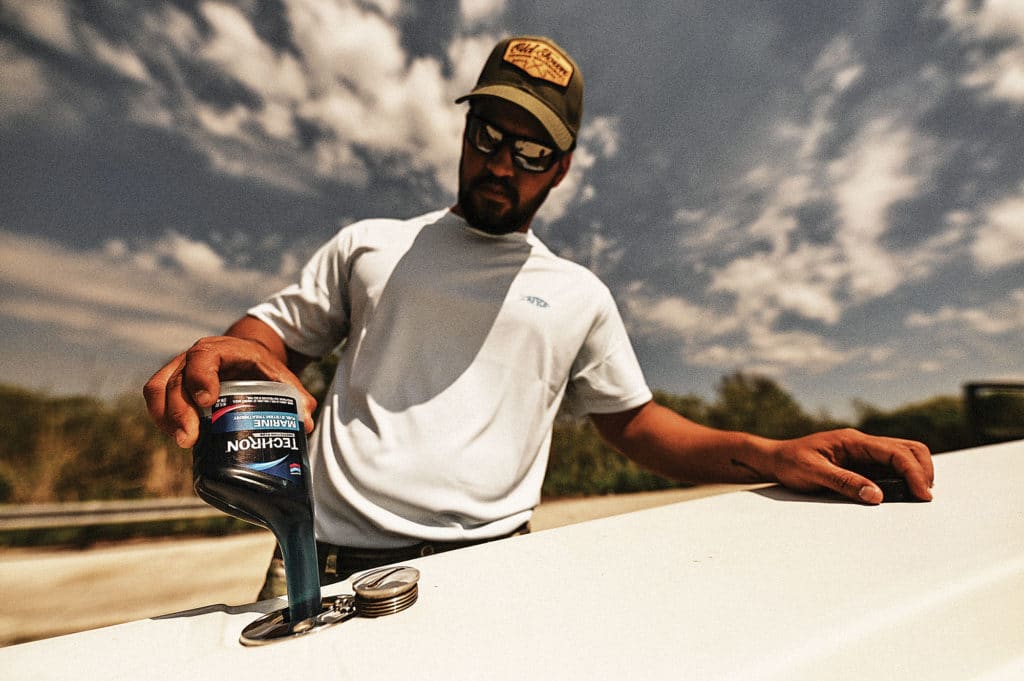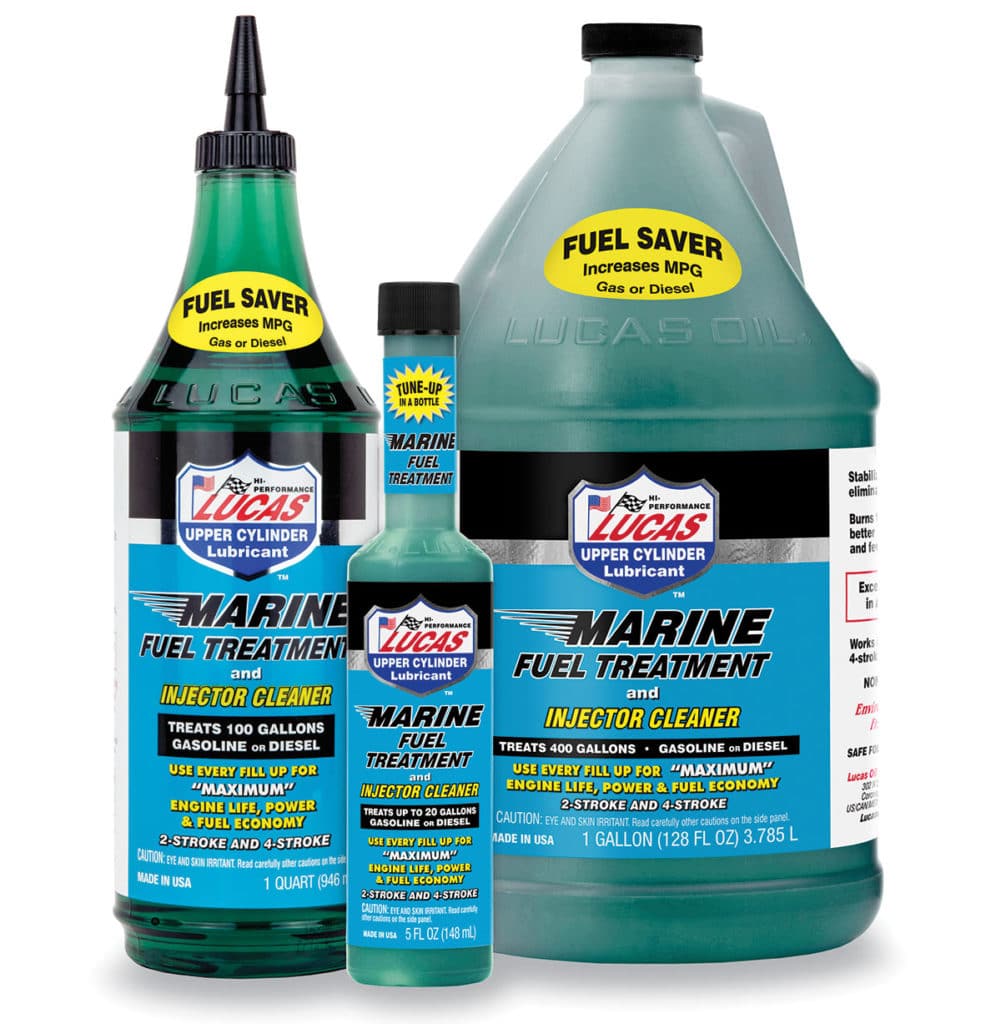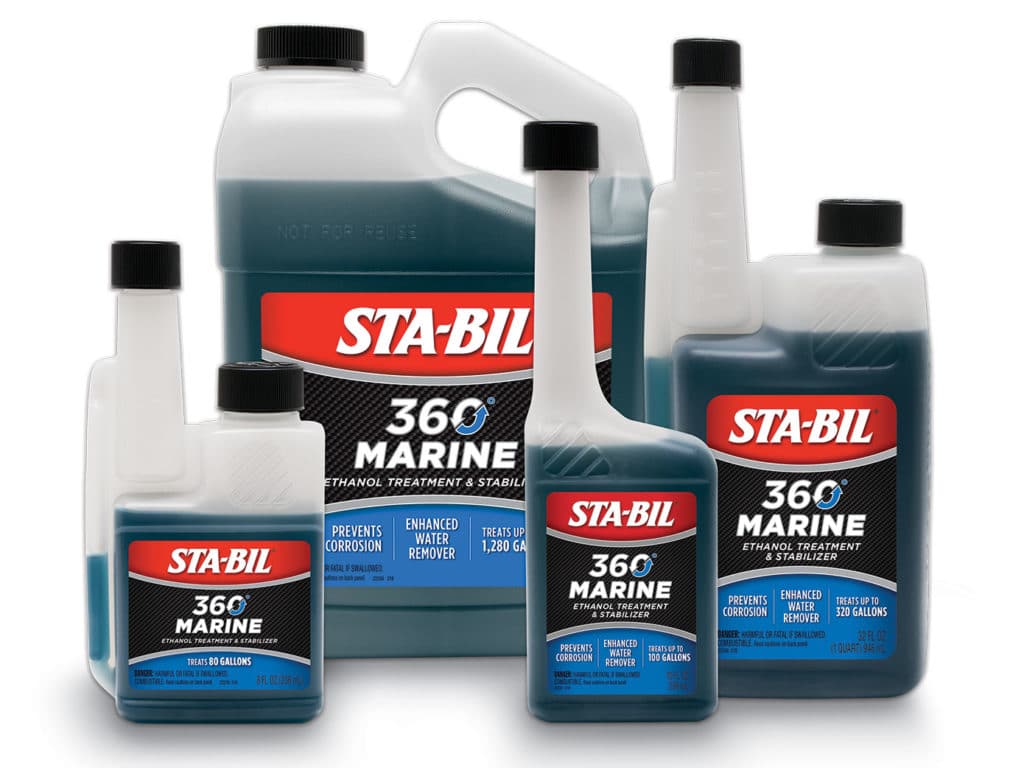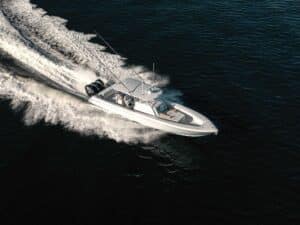
Fuel Additives Help Boaters Manage the Gas in the Tank
Boaters face critical fuel issues that most motorists rarely think about. One issue, for example, is the long-term stability of the gasoline in the boat’s fuel tank. Many boats are not driven every day, as are most automobiles. Stored fuel can grow stale over time, and that can result in clogged carburetors and fuel injectors.
Since vessels operate in a wet environment, boaters also face the issue of corrosion throughout the fuel system. Long periods of operation at the same rpm can lead to carbon buildup on the valves, cylinders, pistons and rings of a marine engine. And finally, there’s the specter of ethanol in gasoline that can attract moisture and, over time, result in phase separation that can damage fuel-system components as well as the engine itself.
It’s not easy to maintain fuel quality in a world of water and salt. The good news is that companies such as Chevron Lubricants, Lucas Oil, Sta-Bil, and others have stepped up with marine fuel-system treatments engineered to help manage the quality of gasoline in your tank and optimize the performance of your marine engine, be it an inboard or outboard.
“The continuous use of a fit-for-purpose marine fuel additive is perhaps more necessary and more important for boaters than it is for any other user group,” says Joe DeFina, Chevron business manager for fuel additives in North America. “The harsh marine environment, varied engine cycles, and the way boats are operated and stored put boaters in a constant battle with a range of fuel-related issues.”
That said, there is no magic bullet, DeFina adds. “Using a comprehensive marine fuel additive and following good fuel-management practices are the best ways to keep your boat’s fuel system and engine healthy,” he says. Here, then, are maintenance steps you can take to ensure that your boat runs well on the fuel you put in the tank.

Fuel Additives Help Stabilize Gasoline
Stabilize the Fuel
One of the biggest issues facing boaters is maintaining the stability of fuel that’s pumped into the tank. Gasoline begins to degrade immediately and, if untreated, has a shelf life measured in weeks, not months, says Greg Hewgill, technical director for Lucas Oil.
“Over time, gasoline oxidizes and forms films and lacquers that can gum up and clog fuel components such as carburetors and injectors,” Hewgill explains.
A quality additive such as Lucas Marine Fuel Treatment, Chevron Techron Protection Plus Marine Fuel System Treatment or Sta-Bil 360 Marine, designed to be used with every fill-up, can extend gas shelf life for months or even longer, with the proper dosage. Sta-Bil claims that 360 will stabilize gasoline for a year, while Techron Protection Plus stabilizes gas for up to two years, according to Chevron.
While such time frames work for winterization, treatments such as Sta-Bil Storage or Lucas Fuel Stabilizer are engineered exclusively to prevent the breakdown of gasoline during long-term storage. However, these lack the multiple benefits of an “every-fill-up” treatment that addresses other issues.

Fuel Additives Help Fight Corrosion
Clean It Up
One of those issues is carbon buildup, a side effect of hydrocarbon combustion. Marine engines are particularly prone to carbon buildup on valves, pistons and in combustion chambers. This is due to the nature of boating in which marine engines often operate for hours at the same rpm, be it cruising, trolling or idling.
“Continuous operation at a single speed promotes the accumulation of carbon deposits,” Hewgill says. Car and motorcycle engines, on the other hand, rev and decelerate far more often, particularly when shifting gears, and this tends to blow up carbon deposits on an ongoing basis, he explains.
Heavy carbon deposits can restrict airflow through intake valve ports and rob engines of performance and fuel efficiency. Deposits can also lead to rough idling and hard starts. To resolve these issues, marine fuel treatments from Lucas Oil and Chevron Techron contain detergents based on polyetheramine formulations that dissolve and remove the carbon buildup while also providing lubricity.
“Techron is engineered to clean intake-valve deposits in port-fuel-injected engines for smoother idling and enhanced throttle, a difference you may well feel after running just one tank of treated fuel,” says Sean Lantz, mechanical engineer and product technical specialist for Chevron Lubricants.
The detergents in these fuel treatments also remove gum and varnish, an unfortunate byproduct of stale fuel, which clog the tiny ports of carburetors and fuel injectors, hurting engine performance.
Dealing with Water
Water can find its way into a boat’s fuel tank via condensation or other means such as a poor seal at the fuel-fill cap. To stem the intrusion, keep the fuel tank as full as possible between trips. This reduces the space in which condensation can form. Also, make sure the fill cap seals properly.
With non-ethanol gasoline, any water in the tank will descend to the bottom. If you’re running an ethanol-gasoline blend such as E10, minute amounts of water will combine with the fuel in solution. You might not notice any adverse effects until the water content reaches 0.5 percent of the overall volume of fuel.
At this stage, the water-laden ethanol will fall out of solution and collect in a goopy mess in the bottom of the tank. This is a phenomenon known as phase separation.
Read Next: Boaters Note: Tests Show E15 Fuel Could Damage Some Vehicles
In either case, there is no fuel treatment that will remove the water, DeFina says. “Additives that claim to remove water from fuel are not doing that at all, but most likely utilizing emulsifiers or co-solvents that place the water back into the fuel to be burned through the combustion process.
“With all of Techron’s additive formulations, including Techron Marine, adding alcohol or an emulsifier is not consistent with our ‘no-harm’ principles,” he continues. “Adding an additive containing alcohol to fix a fuel issue caused by alcohol (ethanol) is not in the best interest of the boater.”
The same philosophy is shared by Lucas Oil. Its marine fuel treatment does not claim to remove water. “The best way to remove water from fuel is to run the gasoline through a water-separating fuel filter or drain the tank and properly dispose of the contents,” Hewgill says.
Control Corrosion
Any amount of water — particularly salt water — can corrode fuel-system and engine components. But corrosion inhibitors in fuel treatments can provide a high level of protection, tests by Chevron indicate.
In an independent saltwater-corrosion test by the American Society for Testing and Materials, the rust-preventing characteristics of fuel treated with Techron Protection Plus far exceeded that of untreated fuel.
Finally, there are two keys to effectiveness of an every-fill-up fuel treatment. “The first is to follow the dosage recommendations for the volume of fuel in the boat’s tank,” says Chevron’s Lantz. “The second is to dose as soon as possible after you fuel up. That ensures that the treatment will go to work immediately in stabilizing the gas, removing carbon deposits and fending off corrosion.”








